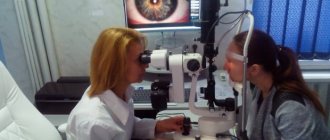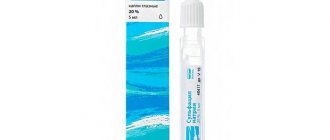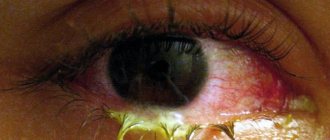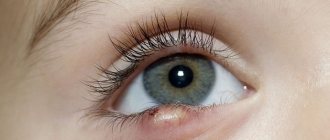In what cases is it prescribed?
The inflammatory process is provoked by pathogenic microorganisms and is accompanied by itching, swelling, redness, and photophobia. Indications for the use of eye ointment with an antibiotic for inflammation:
- Keratitis is an inflammatory reaction, the signs of which are pain, fear of light, clouding and swelling.
- Blepharitis is a group of diseases in which bilateral or unilateral damage occurs with the appearance of yellow crusts and loss of eyelashes.
- Corneal ulceration is a thinning of the cornea, destruction of the upper layer of the epithelium, affecting the stroma.
- Conjunctivitis is a bacterial or viral inflammatory process.
- Hordeolum is a lesion of the hair follicle or sebaceous glands with accumulation of pus.
Ointments are also prescribed in the period after surgery for preventive purposes to prevent the addition of a bacterial infection and speed up tissue healing.
How to choose a cream for puffiness under the eyes in a pharmacy
Ladies are accustomed to eliminating defects on their faces with cosmetics. Changes in facial skin are a problem of internal organs. It would be more useful to go to the pharmacy for recommendations. There are a lot of good anti-edema products sold there.
One of them is heparin ointment. It helps well with swelling under the eyes. The heparin it contains prevents rapid blood clotting. The ointment has an anti-exudative effect - it promotes the resorption of fluid secreted by inflamed capillaries.
Heparin reduces inflammation and stimulates blood circulation. The ointment resolves hematomas and reduces swelling
Classification of antibacterial eye ointments
In medical practice, broad-spectrum ointments are more often used. Based on the name of the active substance, they are usually classified as follows:
- Macrolides. They give a bacteriostatic effect, preventing the reproduction and growth of bacteria. Drugs of semi-synthetic or natural origin are less toxic than the quinolone group. Due to the minimal list of contraindications, antibiotics of this group are more often prescribed to pregnant women and children.
- Fluoroquinolones, quinolones. Antibiotics for eye inflammation, inhibiting the growth of bacteria. They contain synthetic active ingredients - DNA gyrase inhibitors, which are introduced into the DNA structure of the pathogen and lead to its death.
- Aminoglycosides. The first group is least effective. Modern aminoglycosides, which belong to the third generation, act quickly, give a minimum of side effects and cope even with multi-resistant microflora.
- Levomycetins. Popular and cheap antibiotics of synthetic origin. RNA and DNA penetrate into cells and inhibit protein synthesis, thereby inhibiting the proliferation of bacteria.
In ophthalmological practice, topical medications are prescribed not only for inflammation, but also for thermal and chemical burns and injuries.
Cream composition
Eye creams often contain the following ingredients:
- Zinc oxide. The substance is used to relieve inflammation.
- Calf's blood. In cosmetology, an extractor is used. It accelerates the process of oxygen delivery to tissues.
- Tetracycline. The antibiotic and its derivatives destroy bacteria.
- Glycerol. The amino acid softens the skin and helps retain moisture.
- Aloe vera. The substances contained in this plant give the skin elasticity. They slow down aging.
- Hyaluronic acid. This substance is part of the connective and nervous tissues of the human body. As a component of an ointment for the skin around the eyelids, it smoothes the skin and gives it elasticity.
- Beeswax. A substance secreted by specific glands of bees. It retains water, maintaining the skin's natural moisture.
- Horse chestnut. An extract of the plant is used in ointments and creams. It has a strong anti-edematous effect. With the help of this substance it is easy to relieve swelling.
- Troxerutin. The substance has anti-edematous and antioxidant effects. They relieve swelling and resist aging.
- Heparin. Anticoagulant relieves inflammation.
All 10 components cannot be found in one ointment. You need to choose a cream with the largest number of them.
List of the best ointments
Local medications for purulent, infectious or inflammatory damage to the organs of vision are prescribed by the doctor after examination. Ointments are often recommended to be combined with eye drops for eye inflammation with an antibiotic, which allows you to quickly get rid of symptoms and speed up recovery.
Popular titles:
- Tsiprolet . Thick ointment is used to treat keratitis, conjunctivitis, bacterial corneal ulcers, barley, blepharitis. Belongs to the group of fluoroquinolones and has an antimicrobial effect. Not approved for use in children under 2 years of age.
- Tobradex . Contains aminoglycosides and glucocorticosteroid dexamethasone. Combined drug with a wide spectrum of action. It is used to treat keratitis, iridocyclitis, blepharitis, to prevent inflammation and after surgery. Approved for use by adults only.
- Erythromycin ointment . The cheap product includes antibiotics from the macrolide group, effective against staphylococci, streptococci, corynobacteria and more than 20 types of pathogens. Used in the treatment of keratitis, conjunctivitis and corneal ulceration.
- Phloxal . Antimicrobial agent for external use of the fluoroquinolone group. Effective against gram-negative and gram-positive microorganisms. Suitable for the treatment of infectious and inflammatory lesions of the anterior parts of the eyes. Approved for use in children.
- Tetracycline ointment . A budget pharmaceutical product containing tetracycline hydrochloride, which has a wide spectrum of bacteriostatic effects. It is used mainly for the treatment of streptococcal and staphylococcal lesions of the cornea and conjunctiva.
- Neladex . The combination of an antibiotic and dexamethasone has antiallergic, antibacterial and anti-inflammatory effects. Used in the treatment of iridocyclitis, keratitis, blepharitis, conjunctivitis, as well as for the treatment of otitis media. Do not use for children, women during lactation and pregnancy.
- Eubetal . Contains the antibiotic chloramphenicol and glucocorticosteroids. Can be used in pediatric practice, in women during pregnancy, but under the supervision of a physician. It is a gentle product and has a minimum of contraindications.
- Fucithalmic . An antimicrobial drug in the form of a thick and viscous suspension, belongs to the fusidine group. Allowed for newborns.
The combination of an antibiotic and glucocorticosteroids, mainly dexamethasone, in the ointment makes it possible to expand the range of therapeutic effects. GCS have antiexudative, antiallergic, anti-inflammatory properties - they reduce redness, hyperemia, and accelerate tissue restoration.
Ointment for stye on a child’s eye: an effective remedy for treating eyelids in children
Stye is a common inflammatory disease of the sebaceous gland along the edge of the eyelid. Externally, the pathological process manifests itself in the form of redness, swelling and suppuration. Timely treatment will avoid dangerous complications and relapse.
Cool
Send
Causes of the disease
Frequent causes of barley are hypothermia and bacterial damage. The causative agent is Staphylococcus aureus. Factors provoking the pathological process:
- weakened immune system;
- poor nutrition;
- insufficient hygiene;
- presence of chronic infections;
- concomitant diseases of the eyelids;
- disturbance of sleep and rest patterns;
- chronic diseases of the gastrointestinal tract;
- worms;
- acclimatization after travel;
This disease is often observed in one-year-old children due to the immaturity of the immune system. Genetic predisposition is also of great importance.
How to use eye ointment:
Symptoms in children
The disease develops in several stages. At first there is redness and swelling. This period lasts up to 3 days. During the second stage of development, the formation of a vesicle with pus is observed. After a few days it bursts and all its contents come out.
General symptoms of stye formation:
- swelling;
- itching;
- redness of the eyelid;
- increased body temperature;
- headache.
In some cases, enlarged lymph nodes are observed. When the first signs appear, treatment must begin.
How to treat pathology in childhood
Treatment methods are selected depending on the patient’s age and severity of the disease. It is strictly forbidden to get rid of inflammation mechanically. This is fraught with eyelid abscess or meningitis.
Drug therapy is prescribed. In this case, the doctor takes into account the patient’s condition and medical history. Alternative therapy methods can be used as additional methods.
What absolutely cannot be done when a pathology appears?
For treatment to be effective, you must follow all the doctor’s recommendations. It is strictly forbidden to pierce the abscess and try to squeeze out the pus. This can lead to infection in the orbit of the eye. In particularly advanced cases, death is possible.
If you have stye on your eye, you should not apply compresses. It has been proven that Staphylococcus aureus multiplies in a humid environment. As a result, the bacteria can penetrate the glands and sebaceous sacs.
During treatment the following is prohibited:
- visiting baths and saunas;
- wearing contact lenses;
- washing the eyes with warm water;
- warming up.
Rubbing and scratching the eye can lead to injury to the abscess. As a result, there is a risk of developing an abscess and other complications.
It is forbidden to lubricate the abscess with green iodine or wash it with a solution of potassium permanganate. This may cause a burn to the cornea or mucous membrane. Some methods of traditional therapy are especially dangerous. For example, lotions with urine, saliva or onion juice.
Medicines
The action of medications should be aimed not only at eliminating pathogens, but also at activating the immune system. When prescribing medication, the doctor takes into account the age, severity of the disease and the presence of chronic diseases in the young patient.
The most commonly prescribed treatment is the use of eye ointments and drops. They have anti-inflammatory and antibacterial effects.
In parallel, immunotherapy is carried out. It allows you to increase the protective functions of the body, thereby preventing further relapses.
When body temperature rises and symptoms of body intoxication appear, the doctor prescribes antibacterial drugs in tablet form.
Folk recipes
There are a large number of folk recipes. However, not all of them are safe and effective. Before using them, you should consult a specialist.
The most popular option is to wash the eyes with a solution of strong tea. The following folk remedies give a good effect:
- Plantain. A leaf of the plant should be applied to the affected area. It must first be washed and dried. This bandage should be kept in place throughout the night.
- Calendula. Based on 1 tbsp. flowers and a glass of boiling water, an infusion is prepared. It is used for lotions. If a head with pus has already formed in a large area, you should avoid warming up. Otherwise, the infectious process may intensify.
- Flax-seed. It is used as a dry compress. The seeds are heated in a frying pan, tied into a tight bag and applied to the affected eyelid. The duration of the procedure is 15 minutes. The seed can be replaced with sea or table salt.
- Aloe. This plant allows you to speed up treatment. The lower fleshy leaf is crushed and filled with a glass of water. The product should infuse for 24 hours. The finished medicine is used for lotions.
To boost your overall immunity, it is recommended to drink a variety of herbal decoctions. To prepare a home remedy you will need:
- series;
- Birch buds;
- violet grass;
- calamus root;
- wild rosemary
All components are mixed, crushed and poured into 1 liter of boiling water. The drink is simmered over low heat for 10 minutes and then aged for about 12 hours.
This remedy should be drunk half a glass 30 minutes before meals. A small amount of honey is added to improve the taste.
Before using any folk remedy, you need to make sure there is no allergic reaction.
What if a baby’s abscess doesn’t go away?
In most cases, an abscess forms 2-3 days after the onset of the disease. On day 4-5 it opens. With internal barley, surgical intervention is required to safely open the formation and remove its contents.
Sometimes barley can go away without the formation of an abscess and an inflammatory process.
Using ointments: pros and cons
Ointment for barley can be used in combination with drops or as an independent method of treatment. The main advantage of this dosage form is ease of use. The product is simply applied evenly behind the lower eyelid, thereby distributing it over the source of infection.
This dosage form provides an immediate therapeutic effect. The affected eye receives the required amount of medication.
Before using the ointment, you must study the instructions in detail. Not all drugs are suitable for children. The form of the disease is of great importance. There are drugs that will be ineffective for the external form, while others will only work for the internal form of barley.
How to properly apply medications to children?
Before applying the ointment, it is necessary to test for an allergic reaction. To do this, apply a small amount of the product to the bend of the elbow. If no reaction is observed, then the product can be used.
The ointment should only be applied with clean hands. Otherwise, secondary infection is possible. In most cases, the medicine is placed under the eyelid. If the abscess is located outside, then the procedure is carried out without pawning.
The medicine must be applied before opening the abscess and for several days after. If severe itching or burning occurs, you need to wash off the remaining ointment and consult a doctor.
List of the best drugs
The doctor selects the drug, dosage and sets the duration of the therapeutic course. If its recommendations are not followed, side effects in the form of local reactions may occur.
Tetracycline
Tetracycline ointment has a quick and effective effect. The medicine is not suitable for treating children under 5 years of age or if there is a severe allergic reaction to its components.
Tetracycline provides antiseptic, antibacterial and anti-inflammatory effects. The dosage is prescribed by the doctor. Most often, two uses per day are sufficient. Apply the ointment thinly. There are no side effects.
Erythromycin
Erythromycin ointment contains an antibiotic from the macrolide group. It is effective against staphylococci. It is recommended to apply the product to the affected area 2 times a day. The product can be applied directly to the eyelid or on a bandage.
Synthomycin
The active ingredient in Synthomycin ointment is chloramphenicol. It has a pronounced antibacterial and bactericidal effect. It is recommended to apply the medicine 3-4 times a day. There are no contraindications, but sometimes allergic reactions in the form of rash and itching can occur.
Hydrocortisone
Hydrocortisone ointment is not the main treatment for stye. It is used in combination with another antibiotic. The product does not have an antibacterial effect, but it effectively eliminates the symptoms of the pathological process.
The product has antiallergic, antihistamine and exudative effects. The use of hydrocortisone ointment should be avoided for skin diseases of the eyelids, viral and fungal infections.
Vishnevsky
Vishnevsky ointment is often prescribed for the treatment of inflammatory diseases. However, it is only suitable for external therapy. Its peculiarity is its natural composition.
Active substances help relieve swelling, eliminate signs of inflammation and pain. As a result, the regeneration process occurs faster.
Oxolinic
Oxolinic ointment consists of two components: petroleum jelly and tetraxoline. The medicine has a pronounced immunostimulating and antiviral effect. It is well tolerated by the mucous membrane of the eyes.
Oxolin is recommended to be applied 2 times a day. After the first use, there may be a slight burning sensation, but it goes away quickly.
Ichthyol
To eliminate barley, ichthyol ointment is prescribed only in combination with an antibiotic. It contains:
- tar;
- oils;
- resins;
- sulfur.
Source: https://proglaza.net/lechenie/glaznye-mazi/ot-yachmenya-rebenku
Features of application
When prescribing antibacterial ointments, the age of the patient, the type of pathogen, if appropriate research is carried out, and the severity of symptoms are taken into account. It is also necessary to exclude individual intolerance or allergies to certain components of the product.
In children
In pediatric practice, antibacterial agents in the form of eye ointments are used less frequently than drops. This is due to the fact that a child, especially in the first years of life, is less able to tolerate putting a drug with a thick consistency behind the eyelid.
When choosing an eye ointment with an antibiotic for inflammation of the eyelids, preference is often given to macrolides. They are distinguished by low toxicity, the ability to accumulate in the tissues of the organs of vision, and a pronounced bacteriostatic effect. The ability of macrolides to accumulate in tissues to a greater extent than to penetrate into the blood makes drugs based on them effective, but gentle on the child’s body.
Contraindications
Antibiotic ointments are practically not prescribed to women during breastfeeding and pregnancy, since the effect of the active substances on the fetus and breast milk has been little studied. Other contraindications:
- children's age - most drugs in ointment form are not allowed for use in children under 1–3 years of age;
- serious disturbances in the functioning of the liver and kidneys;
- allergy to components;
- increased sensitivity.
The choice of ointment or eye drops - anti-inflammatory, antibiotics or combination drugs - is also based on the type of pathogen. There are products that are effective only against specific bacteria. If the pathogen is unknown, the doctor will suggest a broad-spectrum medicine.
Side effects
If you follow the instructions, the risk of side effects is minimized. However, the following conditions rarely occur:
- lacrimation;
- irritation, redness of the skin of the eyelids;
- swelling of the eyelid tissues;
- sensation of a foreign body in the eyes;
- photophobia;
- itching
Common symptoms include vomiting, nausea, changes in appetite, and indigestion. Uncontrolled use of products with glucocorticosteroids increases the risk of developing a secondary infection.
Top 10 drugs from the pharmacy
Antibiotic eye ointments actively suppress most types of known pathogenic bacteria and relieve existing inflammatory processes, restoring full health to a person. Among the best drugs for the treatment of eye diseases are several highly effective and fairly affordable drugs.
Tetracycline ointment
Indications for the use of this ophthalmic drug are such dangerous diseases as:
- Conjunctivitis.
- Blepharitis.
- Trachoma.
- Keratitis.
1 g of ointment contains 10,000 mcg of pure tetracycline. It is produced in tubes of 3.7 or 10 g.
The pharmacological effect of the drug is its fight against pathogenic microorganisms and the provision of a full bacteriostatic effect. However, in the case of viral conjunctivitis or the presence of a fungus, this ointment will be practically ineffective.
The drug is used according to the following scheme: it is placed behind the lower eyelid no more than 5 times a day.
The main contraindication to the use of the drug is human intolerance to tetracycline itself. A side effect of the drug is the occurrence of a local allergic reaction (burning in the eyes, swelling, itching). There were no episodes of ointment overdose. It is available without a prescription. The cost of the medicine is approximately 40 rubles. per package.
Ofloxacin
Antibiotic eye ointment containing 3 mg ofloxacin per 1 mg of its composition. Vaseline, methyl parahydroxybenzoate and propyl parahydroxybenzoate are also used as additional substances.
Ofloxacin has a unique mechanism of bactericidal action from a biological point of view, which manifests itself in a decrease in the activity of DNA gyrase, and this in turn stops the replication of bacterial DNA.
Indications for use of the drug are:
- diseases of the eyelids of bacterial origin.
- dacryocystitis, meibomitis;
- eye infections caused by chlamydia;
- prevention after various types of surgical interventions in the visual organs (eye injuries, removal of foreign bodies).
The drug must be used according to the following scheme:
- Carefully pull back the lower eyelid of the affected eye.
- 1 cm of ointment is injected into the conjunctival sac.
- Close the eye and rotate it to distribute the drug evenly inside.
This whole procedure is carried out 2-3 times a day for a period of no more than 2 weeks.
Side effects of using the ointment may include:
- burning and discomfort in the eyes.
- dryness, itching, fear of light.
- active lacrimation.
Clear contraindications to the use of the drug include:
- age up to 15 years.
- pregnancy and lactation.
- high sensitivity to the components of the ointment or intolerance to them.
There is no evidence of drug overdose. It is recommended to start driving a car no earlier than 15-20 minutes after putting the ointment in the eyes. The ointment is sold without a prescription at a price of approximately 60 rubles.
Phloxal
The drug serves to relieve inflammation in the eyes caused by diseases such as:
- blepharitis;
- barley;
- corneal ulcer;
- keratitis;
- chlamydial pathogen.
Eye ointment is placed inside the lower eyelid with a strip 1.5 cm long. The procedure is performed no more than 3 times a day. The course of treatment should not exceed 2 weeks. Parallel use of ointment and drops is allowed.
Floxal has a wide spectrum of action, which allows it to suppress gram-positive microorganisms.
Side effects of the drug may be:
- fear of light;
- discomfort in the eyes;
- dryness or, on the contrary, lacrimation;
- dizziness.
Pregnant and lactating women, as well as persons who are hypersensitive to the components of the ointment, should not use the drug.
There have been no cases of Floxal overdose. Do not wear contact lenses while using it. The drug is sold by prescription. The price is in the range of 140 – 190 rubles.
Erythromycin
The eye ointment is yellowish (in some cases yellowish-brown) in color. Contains 0.01 g of erythromycin.
The following are used as additional substances:
- petrolatum;
- anhydrous lanolin;
- sodium metabisulfite.
Erythromycin belongs to the group of macrolides and is able to be absorbed directly into the cornea of the eye, as well as into the watery structure of this organ.
The drug is prescribed if a person suffers from:
- blepharitis;
- meibomite;
- conjunctivitis;
- trachoma.
Persons suffering from kidney or liver failure are prohibited from using the drug. There are no clinical trials of the drug on its effects on pregnant and lactating women.
The drug must be used as follows: a strip of ointment no more than 1.5 cm long must be placed behind the eyelid of the diseased eye. This procedure is carried out 3 times a day. The duration of treatment depends on the specific disease and the severity of its course and therefore can range from 14 days to 4 months.
To combat trachoma, the drug is used 4-5 times a day with parallel opening of the follicles, and after the active inflammatory process has subsided, treatment follows the standard regimen.
The medication can be used to prevent blenorrhea in newborns. To do this, the ointment is placed behind the lower eyelid once a day.
An overdose of the drug has never been officially recorded.
Side effects of the ointment may include active lacrimation and impaired visual clarity. The drug is dispensed through pharmacy chains with a prescription from a doctor. Cost - about 90 - 100 rubles.
Hydrocortisone
An ointment containing the following components:
- hydrocortisone acetate;
- methylparaben;
- soft, white paraffin.
The preparation must have a uniform consistency. By itself, it has the ability to reduce inflammatory cell infiltrates, reduces the migration of leukocytes and lymphocytes in the area of inflammation. Hydrocortisone penetrates into the epidermis and epithelial layer of the mucous membrane.
The medicine is prescribed by a medical professional if the patient has:
- allergic conjunctivitis;
- iridocyclitis;
- keratitis;
- chemical burn;
- postoperative irritation.
Clear contraindications to the use of ointment may be:
- open glaucoma;
- fungal eye infections;
- eye tuberculosis;
- ulcers and wounds of the cornea;
- viral diseases of the visual organs;
- intolerance to the components of the drug;
- violation of the integrity of the structure of the eyeball;
- the patient's age is less than 18 years.
The effect of the drug on pregnant or lactating women has not been studied. There is no data on the penetration of glucocorsteroids into breast milk. Eye ointment is used locally: it is placed in the conjunctival sac in a strip up to 2 cm long no more than 3 times a day.
Side effects of the drug:
- short-term visual impairment;
- increase in eye pressure if treatment lasts more than 10 days;
- formation of subcapsular posterior cataract;
- decreased rate of healing of wounds that occur when the cornea thins;
- the occurrence of fungal infection.
Episodes of overdose are extremely rare and manifest themselves in the occurrence of local dose-dependent negative effects. If you stop using the drug, the manifestations of overdose disappear on their own. The ointment is available without a prescription at any pharmacy at a price of 30 rubles.
Posiformin
Eye ointments with an antibiotic, which is posiformin, are characterized by a broad antimicrobial effect. This drug contains 20 mg of bibrocathol in 1 g of its composition, as well as lanolin and mineral oil.
The drug is prescribed to persons suffering from:
- nonspecific irritations of the outer shell of the eyeballs;
- chronic blepharitis;
- fresh uninfected wounds of the cornea.
Posiformin provokes the deposition of proteins that bind the surface layers of tissues. Thus, a protective layer is formed that helps prevent the penetration of pathogenic elements. This becomes possible thanks to the presence of bibrocathol, which is a specific bismuth compound endowed with astringent and antiseptic properties.
Main contraindications to the use of the medicine:
- increased human sensitivity to the main or auxiliary components;
- age under 6 years;
- wearing contact lenses during treatment.
The ointment is used according to the following scheme: a strip 0.5 cm long is inserted into the conjunctival sac or onto the affected eyelid. The procedure is carried out up to 5 times a day. For adults and children over 6 years of age, the dosage is the same. Application period – up to 14 days.
An overdose is unlikely, since bibrocatol has a low degree of penetration through the biological membrane into the inside of the eye.
The use of the ointment by pregnant and lactating women is undesirable, since there is no accurate data on the degree of exposure of the drug to these categories of women. Posiformin is sold as prescribed (prescribed) by a medical professional. The cost of the drug is quite high - about 1900 rubles.
Tobradex
An antibiotic drug containing 3 mg of tobramycin and 1 mg of dexamethasone in 1 g of its composition. These eye ointments produced in Belgium also contain anhydrous chlorobutanol, mineral oil, and white soft paraffin.
The drug is prescribed when the patient has inflammation of the eyes with a bacterial infection, which is suppressed by blocking the ribosomes of harmful microorganisms, which reduces protein synthesis and the vital activity of the pathogen.
Tobradex is prohibited for use when a person suffers from:
- keratitis, which was caused by the herpes simplex virus;
- viral infections of the cornea and conjunctivitis;
- fungal eye diseases;
- microbacterial infections of the visual organs.
During pregnancy, the use of ointment is also prohibited because there is a risk of intrauterine growth retardation. Tobradex is non-toxic even if accidentally swallowed. Excess ointment in the eye is simply washed off with water.
Side effects often include:
- burning and itching;
- swelling and lacrimation;
- erythema;
- increased intraocular pressure.
However, these manifestations occur in only 1% of patients using the drug, which is sold by pharmacists exclusively by prescription. The price of the ointment is about 400 rubles.
Alfatex
An eye ointment containing the following main active ingredients:
- chloramphenicol;
- colistimethate sodium;
- tetracycline;
- betamethasone disodium phosphate.
The drug is prescribed to combat gram-positive and gram-negative bacteria, causative agents of various purulent infections, and affects rickettsia, spirochetes, and chlamydia. The ointment also has antifungal activity.
The drug is prescribed in cases of combating:
- conjunctivitis;
- keratitis;
- blepharitis;
- injuries and other damage to the visual organs.
Alfatex is used 3-4 times a day. It can be used in conjunction with eye drops, which are instilled in the morning, and the ointment is applied in this case in the afternoon.
Possible side effects:
- asthma attacks due to the presence of sodium sulfate in the ointment in people with acute sensitivity to this substance;
- increased intraocular pressure;
- posterior subcapsular cataract.
Prohibitions for using the drug are:
- glaucoma;
- viral diseases of the cornea;
- eye tuberculosis.
No cases of drug overdose have been identified. It is sold in pharmacies without a prescription at a price of about 2,000 rubles.
Colbiocin
Eye ointments with an antibiotic must also be considered with Colbiocin, which contains:
- colistimethate sodium;
- chloramphenicol;
- tetracycline;
- Vaseline oil;
- Vaseline for eyes.
This drug is a semi-solid liquid mass that is prescribed for:
- conjunctivitis (catarrhal, purulent, trachoma);
- blepharitis;
- bacterial keratitis;
- septic corneal ulcer;
- blepharoconjunctivitis;
- dacryocystitis.
The ointment inhibits the synthesis of proteins of harmful microorganisms and is active against gram-positive and gram-negative bacteria.
Unambiguous prohibitions on the use of the drug are:
- disorders of the kidneys and liver;
- pregnancy and lactation;
- age up to 8 years;
- intolerance to the components of the drug.
Side effects of Colbitsion:
- burning in the eyes;
- hives;
- short-term conjunctival hyperemia;
- bone marrow hypoplasia due to long-term topical use.
Eye ointment is applied to the lower conjunctival fornix up to 4 times a day. The drug is dispensed without a medical prescription from a doctor. The cost of the medicine ranges from 250 rubles.
Tsiprolet
An eye ointment that inhibits bacterial DNA gyrase and disrupts the synthesis and division of harmful microorganisms by destroying their membranes and cell walls.
The description of the drug is given in the table below:
| Compound | Diseases | Locked for reception | Side effects |
|
| Children under 2 years of age Hypersensitivity to existing components |
|
The drug is sold freely through pharmacy chains without a medical prescription, and its price starts from 50 rubles.
Modern eye drops are presented on the pharmacological market in a fairly large assortment. The exact selection of drugs with antibiotics for a sick person can always be carried out by his attending physician. The medical professional also determines the procedure for using the drug, the frequency of its administration and the duration of the course.
It is important to understand that if the ointment does not bring the desired effect after 3 days, then this is a serious signal that the drug needs to be replaced so that the negative consequences in no way increase from an existing infection of the visual organs.
Self-medication is also very dangerous, which can sometimes have a negative impact on the final result when it comes to getting rid of eye diseases.
How to use it correctly?
Place the ointment behind the lower eyelid. You can do this in two ways:
- Use of a special glass spatula. Before the procedure, wash your hands thoroughly, warm the ointment in your palms to room temperature so that it dissolves faster in the tear. Squeeze a 1 cm long strip onto a clean sterile spatula, pull back the edge of the lower eyelid, roll your eyes upward and place the medicine in the conjunctival sac. After this, close your eyes for at least 10 seconds and help. Remove any ointment that has come out with a napkin, cotton swab or disk.
- Squeezing out of a tube. Budget ointments, for example, tetracycline, are available in wide-necked tubes. Expensive analogues have a special narrow spout, which makes it easier to insert the product. The algorithm is the same, but before each use, wipe the narrow spout of the bottle with a disinfectant.
You can put on contact lenses when treating with eye ointments 15 minutes after use. When using drops simultaneously, the interval between procedures is 30–60 minutes.
Antibiotic eye ointments “do not work” if the disease is viral. For example, abundant mucous or purulent discharge and the severity of symptoms speak in favor of bacterial conjunctivitis. At the same time, bacterial species are more sensitive to treatment with antibacterial ointments.
- Category: Articles
How to apply ointment when treating eyes?
The patient will be able to place the ointment for effective treatment of eye inflammation behind the eyelid without assistance.
To apply the product correctly, you must follow certain rules:
- Use an alcohol wipe and hot water to disinfect the glass rod intended for uniform application of the gel. But if the tube of ointment is equipped with a special nozzle, then additional devices are not needed.
- You should prepare a paper or gauze napkin.
- If the tube of ointment is stored in a cold place, then it must be warmed in a glass of warm water before use.
- Before applying the product, the skin around the eyes should be cleaned and all makeup removed.
- Purulent discharge must be removed with a special antiseptic.
- Before applying the ointment, you should wash your hands with soap and sit in front of a mirror.
- Squeeze a little ointment onto a glass spatula and pull the lower eyelid down with your index finger.
Eye ointment for inflammation is applied behind the conjunctiva
- With the other hand, the medicine is placed into the free cavity between the eyeball and the eyelid, after which the eyelid is released.
- You need to blink several times and remove excess ointment with a clean napkin.
- All that remains is to perform a similar procedure with the second eye and lie quietly for 20 minutes.
As a natural antiseptic, you can use chamomile decoction or fresh brewed black tea. Furacilin solution is no less effective. To do this, grind 1 tablet of the drug into powder and add 100 ml of hot water. Soak a cotton swab in the solution and treat problem areas.
Masks against wrinkles and swelling at home
Traditional medicine offers its own recipes for edema. They use ingredients that you always have at home.
The simplest mask for eyelid swelling is fresh grated potatoes. One potato should be grated and placed on gauze or bandage. Place gauze over the eyes. Keep for a quarter of an hour. The swelling will go away.
The second way to relieve swelling is green tea tincture. They brew it, let it brew and make lotions.
An ancient remedy for swelling is fresh cucumbers. They are cut into circles and applied to the eyes. Keep it for a quarter of an hour. At the end of the procedure, wash your face with cold water.
Crushed parsley root applied to the eyelids will help get rid of swelling and smooth out wrinkles.










